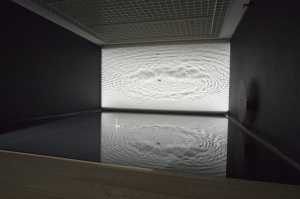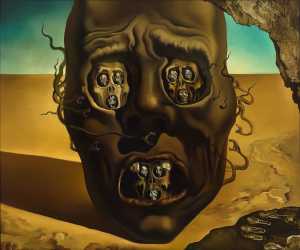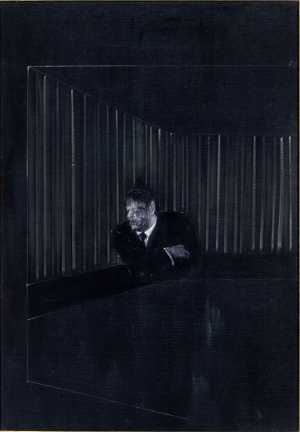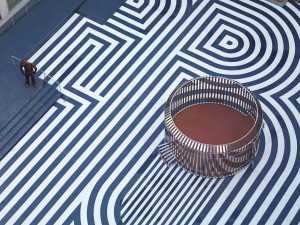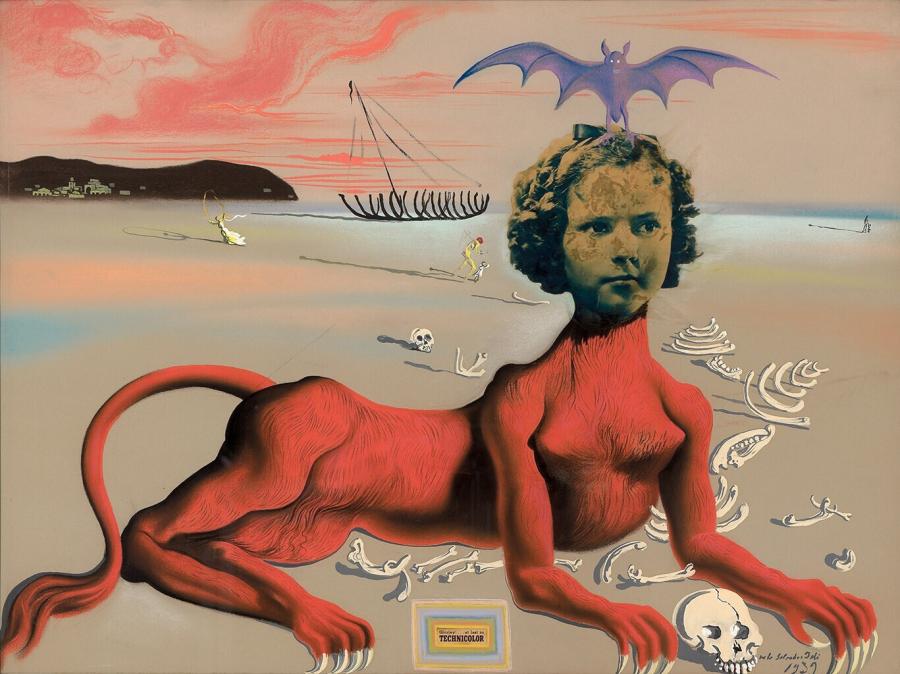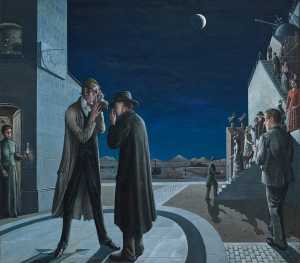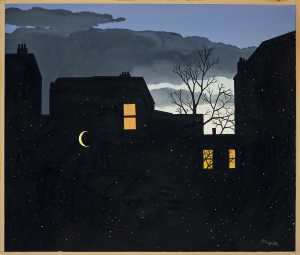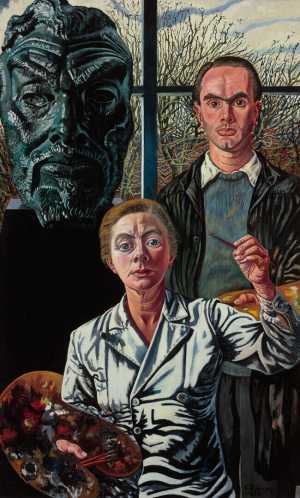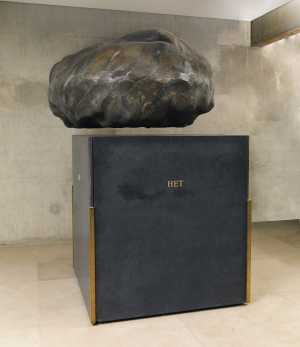Shirley Temple was a popular child star in the 1930s. In this fantasy image of the Hollywood starlet, Dalí has collaged her head, taken from a magazine, onto the body of a lion. He has transformed her into a modern sphinx, who devours her public.

Specifications
| Title | Shirley Temple, le plus jeune monstre sacré du cinéma de son temps |
|---|---|
| Material and technique | Gouache, pastel and collage on cardboard |
| Object type |
Painting
> Painting
> Two-dimensional object
> Art object
|
| Location | This object is in storage |
| Dimensions |
Width 100 cm Height 75 cm |
|---|---|
| Artists |
Artist:
Salvador Dalí
|
| Accession number | 2751 (MK) |
| Credits | Purchased 1969 |
| Department | Modern Art |
| Acquisition date | 1969 |
| Creation date | in 1939 |
| Entitled parties | © Salvador Dalí, Fundación Gala-Salvador Dalí, c/o Pictoright Amsterdam 2022 |
| Provenance | Galerie André-François Petit, Paris; Claude Rivière, Paris; Joseph Foret, Paris; Nathalie Krebs; Jean Krebs |
| Exhibitions | New York 1939; Tokyo 1964; Paris 1965; Charleroi 1968; Rotterdam 1968; Rotterdam 1970-71; Baden-Baden 1971; Barcelona/Madrid 1983; Charleroi 1985; Barcelona/Madrid/St Petersburg 2004-05; Rotterdam 2005a; London 2007b; Milan 2010-11; Rotterdam 2011; Rotterdam 2013-2014a; Rotterdam 2017b |
| Internal exhibitions |
Een prikkelcollectie (2000) Een paraplu, een naaimachine en een ontleedtafel. Surrealisme à la Dalí in Rotterdam. (2013) Collectie - surrealisme (2017) |
| External exhibitions |
Fantastic Animals (2023) IMAGINE! 100 Years of International Surrealism (2024) GIRLHOOD. On Boredom, Rebellion and Being In-Between (2025) Museum Boijmans Van Beuningen @ Rijksmuseum (2023) |
| Research |
Show research A dream collection - Surrealism in Museum Boijmans Van Beuningen |
| Literature | Rotterdam 1970, cat. no. 126; Chadwick 1994, pp. 24-25, fig. 15; Descharnes 1997, p. 252; Barcelona/Madrid/St Petersburg 2004-05, fig. 124, p. 93; Figueres 2004-present, cat. no. 509; Rotterdam/Barcelona/Madrid 2005, p. 134 |
| Material | |
| Object | |
| Technique |
Gouache
> Drawing technique
> Technique
> Material and technique
|
| Geographical origin | Spain > Southern Europe > Europe |
Entry catalogue A dream collection - Surrealism in Museum Boijmans Van Beuningen
Author: Marijke Peyser
Salvador Dalí’s assemblage Shirley Temple, le plus jeune monstre sacré du cinéma de son temps portrays the American child film star Shirley Temple as a sphinx. A cut-out picture of her head was carefully placed on the body of this mythical monster, executed in pastel chalk and gouache. The sphinx, a winged lion with the head and upper body of a woman, was said to kill travellers if they could not solve the riddles it set them. Skulls, bones and the wreck of what was once a fine sailing ship surround the creature. Although death and destruction predominate, some of the figures in the background recall Dalí’s youth. In the distance, in the upper right corner, walks a minuscule man holding a child by the hand. It is probably a reference to the time when the artist felt safe with his father.[1] The girl with the skipping-rope upper left calls to mind Dalí’s cousin Carolinetta, who died young. He portrayed her in many of his works.[2] The bat above Shirley Temple’s head is an allusion to death, but may also relate to an incident in Dalí’s youth. The artist was around five years old when his cousin gave him a wounded bat. The care of the creature was not a success; soon Dalí saw that it was covered with ants. Out of pity he picked it up and instead of kissing it on the head – as he had intended – he bit it so powerfully that he tore it in half. Horrified he threw it in the sink and ran away.[3] Dalí had a life-long fear of bats.
The world of film permeated the artist’s life; his name is linked to no fewer than fifty cinematographic projects.[4] Although he worked on two Surrealist films with the Spanish filmmaker Louis Buñuel, they were both lovers of American movies starring Buster Keaton, Ben Turpin and Harry Langdon.[5] They disliked European art cinema, which was saturated with culture.[6] Dalí thought that ‘a film should be like a car, an aeroplane or a gramophone: intense, happy, pure, dynamic, sharp, funny, perfect’.[7] In his essay ‘A Short Critical History of Cinema’ (1932) Dalí placed the Marx Brothers film Animal Crackers (1930) at the top of the evolution of the film comedy.[8] It was Harpo Marx whom he praised most highly.[9] Dalí went to Hollywood in January 1937 at Marx’s invitation. While he was there he portrayed Marx on the basis of sketches he made during the filming of A Day at the Races (directed by Sam Wood, 1937) in which the actor played the role of Stuff. Two years later he portrayed Shirley Temple at the height of her popularity.
Footnotes
[1] Dalí used this motif many times in his oeuvre, see for example Impressions d’Afrique
(no. 23) or the much later Dalí enfant avec son père (1971).
[2] Including the monumental triptych Landscape with a Girl Skipping Rope (1936), no. 16.
[3] Dalí 1952, pp. 29-30.
[4] Paris 1979, pp. 342-53.
[5] In 1929 Dalí and Buñuel made Un chien andalou. In 1930 they worked together on L'Âge d’or.
[6] Rotterdam/Barcelona/Madrid 2005, p. 119.
[7] Ibid.
[8] Finkelstein 1998, p. 140.
[9] Venice/Philadelphia 2004-05, p. 283.
All about the artist
Salvador Dalí
Figueras 1904 - Figueras 1989
Salvador Dali got to know the author André Breton - the founder of the surrealist movement - while he was studying in Madrid. In 1924, Breton wrote the first...
Bekijk het volledige profiel

